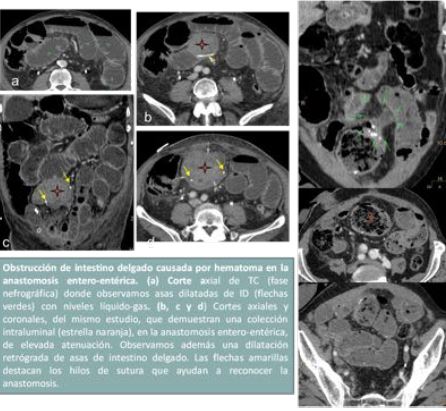DERIVACIÓN URINARIA Y TCMD:
Elección del protocolo idóneo a la hora de evaluar las distintas complicaciones postquirúrgicas.
Palabras clave:
DERIVACIÓN URINARIA, poster, seramResumen
Objetivos Docentes
El propósito principal de este estudio es considerar, analizar y concretar las posibles variaciones técnicas, en el protocolo de la TCMD, para el estudio de las complicaciones postquirúrgicas, precoces y tardías, halladas en el seguimiento de pacientes sometidos a una derivación urinaria.
Para poder llevarlo a cabo, es necesario conocer los tipos más frecuentes de derivaciones urinarias, con el objetivo de estar familiarizados con la anatomía postquirúrgica, y hacer un análisis de las distintas complicaciones.
Revisión del tema
1.- INTRODUCCIÓN
La cistectomía radical con derivación urinaria es un procedimiento quirúrgico complejo con múltiples complicaciones potenciales.
Los principales retos de esta cirugía son proteger el tracto urinario superior y conseguir una reconstrucción anatómica y funcional lo más aproximada a la situación basal pre-quirúrgica.
Los procedimientos quirúrgicos utilizados con mayor frecuencia son tres (Fig.1); uno de ellos incontinente: la derivación cutánea incontinente (Bricker) y los otros dos, el reservorio cutáneo cateterizable y la neovejiga ortotópica, que preservan la continencia.
Descargas
Citas
Hautmann RE, Abol-Enein H, Hafez K, Haro I, Mansson W, Mills RD, et al. Urinary diversion. Urology [Internet]. 2007 Jan [cited 2014 Sep 12];69(1 Suppl):17–49.
Appearances C, Procedures UD, Complications P. Continent Appearances. 1997;(July):173–8.
Exhibit E. CT Findings in Uri- nary Diversion after Radical Cystectomy?: Postsurgical Anatomy. 2009;
Lee RK, Abol-Enein H, Artibani W, Bochner B, Dalbagni G, Daneshmand S, et al. Urinary diversion after radical cystectomy for bladder cancer: options, patient selection, and outcomes.
BJU Int [Internet]. 2014 Jan [cited 2014 Sep 12];113(1):11–23.
Minervini A, Serni S, Vittori G, Masieri L, Siena G, Lanciotti M, et al. Current indications and results of orthotopic ileal neobladder for bladder cancer. Expert Rev Anticancer Ther [Internet]. Informa UK, Ltd.; 2014 Apr [cited 2014 Sep 12];14(4):419–30.
Van Der Molen AJ, Cowan NC, Mueller-Lisse UG, Nolte-Ernsting CC a, Takahashi S, Cohan RH. CT urography: definition, indications and techniques. A guideline for clinical practice. Eur Radiol [Internet]. 2008 Jan [cited 2014 Sep 12];18(1):4–17.
Nolte-Ernsting C, Cowan N. Understanding multislice CT urography techniques: Many roads lead to Rome. Eur Radiol [Internet]. 2006 Dec [cited 2014 Sep 12];16(12):2670–86.
Frank R, Stenzl A, Frede T, Eder R, Recheis W, Knapp R, et al. Urogenital radiology Original article Three-dimensional computed tomography of the reconstructed lower urinary tract?:
technique and findings. 1998;663:657–63
. Lang EK, Macchia RJ, Thomas R, Ruiz-Deya G, Watson R a, Richter F, et al. Computerized tomography tailored for the assessment of microscopic hematuria. J Urol [Internet]. 2002
Feb;167(2 Pt 1):547–54.
Heneghan JP, McGuire K a, Leder R a, DeLong DM, Yoshizumi T, Nelson RC. Helical CT for nephrolithiasis and ureterolithiasis: comparison of conventional and reduced radiation-dose
techniques. Radiology [Internet]. 2003 Nov;229(2):575–80.
Kawamoto S, Horton KM, Fishman EK. Opacification of the collecting system and ureters on excretory-phase CT using oral water as contrast medium. AJR Am J Roentgenol [Internet]. 2006 Jan [cited 2014 Sep 12];186(1):136–40.
Kemper J, Regier M, Stork A, Adam G, Nolte-Ernsting C. Improved visualization of the urinary tract in multidetector CT urography (MDCTU): analysis of individual acquisition delay and
opacification using furosemide and low-dose test images. J Comput Assist Tomogr [Internet]. 2006;30(5):751–7.
13. Mortele KJ, Seifter JL. Multi – Detector Row CT Urography of Normal Urinary Collecting System?: Furosemide versus Saline as Adjunct to Contrast Methods?: Results?: Conclusion?:
;240(3):749–55.
14. Farnham SB, Cookson MS. Surgical complications of urinary diversion. World J Urol [Internet]. 2004 Sep [cited 2014 Sep 12];22(3):157–67.
15. Kawamoto S, Fishman EK. Role of CT in postoperative evaluation of patients undergoing urinary diversion. AJR Am J Roentgenol [Internet]. 2010 Mar [cited 2014 Sep 12];194(3):690–6.
16. Chang SS, Cookson MS, Baumgartner RG, Wells N, Smith J a. Analysis of early complications after radical cystectomy: results of a collaborative care pathway. J Urol [Internet].
May;167(5):2012–6.
17. Gilbert SM, Lai J, Saigal CS, Gore JL. Downstream complications following urinary diversion. J Urol [Internet]. Elsevier Inc.; 2013 Sep [cited 2014 Sep 12];190(3):916–22.
18. Shabsigh A, Korets R, Vora KC, Brooks CM, Cronin AM, Savage C, et al. Defining early morbidity of radical cystectomy for patients with bladder cancer using a standardized reporting methodology. Eur Urol [Internet]. 2009 Jan [cited 2014 Sep 12];55(1):164–74.
19. Van Hemelrijck M, Thorstenson A, Smith P, Adolfsson J, Akre O. Risk of in-hospital complications after radical cystectomy for urinary bladder carcinoma: population-based follow-up study of 7608 patients. BJU Int [Internet]. 2013 Dec [cited 2014 Sep 12];112(8):1113–20.
20. Tsili a C, Efremidis SC, Kalef-Ezra J, Giannakis D, Alamanos Y, Sofikitis N, et al. Multi-detector row CT urography on a 16-row CT scanner in the evaluation of urothelial tumors.
Eur Radiol [Internet]. 2007 Apr [cited 2014 Sep 12];17(4):1046–54.
21. Shinagare AB, Sadow C a, Silverman SG. Surveillance of patients with bladder cancer following cystectomy: yield of CT urography. Abdom Imaging [Internet]. 2013 Dec [cited 2014
Sep 12];38(6):1415.
22. Siegel C. CT urography of urinary diversions with enhanced CT digital radiography: preliminary experience. J Urol [Internet]. 2005 Nov;174(5):1859
23. Daskalopoulos G, Hatzidakis a, Triantafyllou T, Delakas D, Anezinis P, Metaxari M, et al. Intraureteral metallic endoprosthesis in the treatment of ureteral strictures. Eur J Radiol [Internet]. 2001 Sep;39(3):194–200.


